Introduction
The bed gardening created among horticulture enthusiasts became increasingly popular and for a good reason. It provides better soil control, better drainage, and easy access to plants. However, one of the most important aspects of maintaining a healthy bed of high bed is to ensure proper water. In this wide guide, we will find out everything you need to know about a raised bed gardening watering system, from basic to advanced techniques. Whether you are an early or experienced gardener, this post will provide valuable information to help you customize the garden water system.
Why is a Proper Watering System Essential for Raised Bed Gardens?
High-bed gardens are particularly required water than traditional ground gardens. The soil in the high bed dries up rapidly due to better drainage and an increase in contact with air. A properly raised bed gardening can suffer from climbing or water, without a water system, which can lead to poor growth and even death.
A well-designed water system ensures that its plants continuously receive the correct amount of moisture, promote healthy root growth, and maximize the yield. In addition, a skilled water system can save time, water, and long-term efforts.

Types of Raised Bed Gardening Watering Systems
There are many different kinds of watering systems that you can employ in your raised bed garden. Each is good and bad, and what the best will be for you will be based on the size, design, and personal preferences of your garden.
1. Drip Irrigation Systems
Drip irrigation is the best-raised bed garden watering system. It delivers water to the root zone of the plant, saving water and avoiding fungal disease from moist leaves.
- Pros: Saves water, is flexible, weeds are discouraged.
- Cons: Initially costly, and occasionally requires maintenance.
Learn more about drip irrigation systems from The Spruce
2. Soaker Hoses
Immersion hoses are perforated hoses that emit water gradually along its course. Immersion hoses are a cheap and easy installation method for high-bed gardens.
- Pros: Cheap, easy to install, plant friendly.
- Cons: Not as accurate as drip irrigation, will clog after some time.
3. Sprinkler Systems
Sprinkling systems are the standard watering system that can also be used for high-bed gardens. They work satisfactorily in big gardens, but not as effectively as immersion or drip systems.
- Advantages: large areas, simple to automate.
- Disadvantages: Loss of water through evaporation, promotes fungal diseases.
4. Manual Watering
Manual watering with a hosepipe or watering can is the simplest, but time-consuming and tiring.
- Advantages: Low cost, effective control.
- CONS: Retard water, spasmodic watering.

How to Choose the Right Raised Bed Gardening Watering System
When selecting a watering system for your raised bed garden, consider the following factors:
- Garden Size: Larger gardens may benefit from automated systems like drip irrigation or sprinklers, while smaller gardens can be managed with soaker hoses or manual watering.
- Water Efficiency: Drip irrigation and soaker hoses are more water-efficient than sprinklers.
- Budget: Drip systems have a higher upfront cost but can save money in the long run through water savings.
- Maintenance: Consider how much time you’re willing to spend on maintenance. Sometimes the drip irrigation system needs to be cleaned, and other times the entire structure needs to be modified.
Tips for Optimizing Your Raised Bed Gardening Watering System
- Mulch your bed: A blanket of wet grass might aid with more moderate watering while preserving an absorbent floor.
- Water in the morning: Water early in the day reduces evaporation and allows plants to absorb moisture before the heat of the day.
- Monitor soil moisture: Use a soil moist meter to get the right amount of water to your plants.
- Group plants requiring similar water: ensure that all plants in a bed get sufficient moisture without some more water.
Learn more about soil moisture meters from Gardening Know How
DIY Raised Bed Gardening Watering System
If you enjoy projects that you can do you can use easily accessible materials to make your irrigation system. Here is a basic how-to for creating an irrigation system with drips at home:
Necessary materials:
- Poly tubing
- Drip emitters
- Connectors
- Timer (optional)
Steps:
- Place the POLI tube along the high bed length.
- Insert the drip emitters at intervals corresponding to the spacing of your plant.
- Connect the pipe to a water source and add a timer for automation.
Watch a step-by-step tutorial on DIY drip irrigation from YouTube

Common Mistakes to Avoid
- Overwatering: A lot of water can lead to root rot and other problems. Make sure your system offers the right amount of water.
- Underwatering: Inconsistent watering can stress plants and reduce income.
- Ignoring Maintenance: Check your system for clogs or leaks regularly to ensure that it works properly.
Conclusion
A well-designed raised bed gardening watering system is essential for maintaining a healthy and productive garden. If you decide to use a drip irrigation system, immersion, or hand hoses, the critical thing is to ensure your plants receive sufficient and regular moisture. With the advice and methods introduced in this guide, you can design an efficient watering system that saves effort, water, and time and provides lush and healthy plants.
Learn about urban gardening tips from here>>
Frequently Asked Questions
Which moment when day is ideal for watering my garden?
It is early morning because it reduces evaporation and allows plants to absorb water prior to the heat of the day.
How frequently do I need to water my raised bed garden?
Depending on climate plant requirement, and soil type. In general, high beds need watering 2-3 times per week.
Do I have a chance to fit a timer to my irrigation system?
Yes, timers are the best solution to make your irrigation system automatic and uniform.



